This off-road guide is meant to provide advice for when you drive your vehicle off paved roads. Also, see Braking .
Off-road driving can be great fun. But it does have some definite hazards. The greatest of these is the terrain itself.
"Off-roading" means you have left the great North American road system behind. Traffic lanes are not marked. Curves are not banked. There are no road signs. Surfaces can be slippery, rough, uphill or downhill. In short, you have gone right back to nature.
Off-road driving involves some new skills. And that is why it is very important that you read this guide. You will find many driving tips and suggestions. These will help make your off-road driving safer and more enjoyable.
Before You Go Off-Roading
There are some things to do before you go out. For example, be sure to have all necessary maintenance and service work done. Check to make sure all underbody shields are properly attached. Make sure any equipment you may need (first aid kit, cell phone, flashlight, etc.) is securely stored in the vehicle. Be sure you read all the information about your four-wheel-drive vehicle in this manual. Is there enough fuel? Is the spare tire fully inflated? Are the fluid levels up where they should be? What are the local laws that apply to off-roading where you will be driving? If you do not know, you should check with law enforcement people in the area. Will you be on someone's private land? If so, be sure to get the necessary permission.
Removable Side Steps
Your vehicle may be equipped with removable side steps.
Remove the steps prior to off roading to give your vehicle more ground clearance and to prevent damage to the vehicle from the side steps dragging and/or catching on obstacles.
Notice: Do not drive off-road with the side steps attached to your vehicle. You can damage the side steps and/or your vehicle's frame if they get caught or drag against an obstacle. This damage would not be covered by your vehicle's warranty. Always remove the side steps prior to any off-road driving.
U-Type Side Steps
The following instructions show how to install the optional U-type steps. If you want to remove them, just reverse the instructions:
- Start with the side step brackets pointing up and away from you, or just make sure the HUMMER logo faces up.
- For the front step, use the first and third brackets on the vehicle from the front tire. For the rear step, use the first and third brackets on the vehicle from the rear tire.
- Guide the pins on the side step brackets into the holes in the vehicle's rocker panel protector brackets. If you have difficulty doing this, it may help to have someone hold up the step while you guide the pins into the holes.
- Thread the knob through the remaining hole -- first into the rocker panel protector and then into the threaded hole in the side step bracket.
- Hand-tighten the knob by turning it clockwise until it is seated against the rocker panel protector bracket and then tighten it to 10 lb ft (13.5 N·m) with the tool as shown.
You will notice that the side steps have pins on both sides of the step brackets. This is because the steps are interchangeable between front/back and the driver/passenger sides of the vehicle. Use the pins as follows:
| • | Driver Side: Look at the side step with the HUMMER logo facing you. You will use the pins which are on the right side of each side step bracket. This works for the front or rear of the vehicle. |
| • | Passenger Side: Look at the side step with the HUMMER logo facing you. You will use the pins which are on the left side of each side step bracket. This works for the front or rear of the vehicle. |
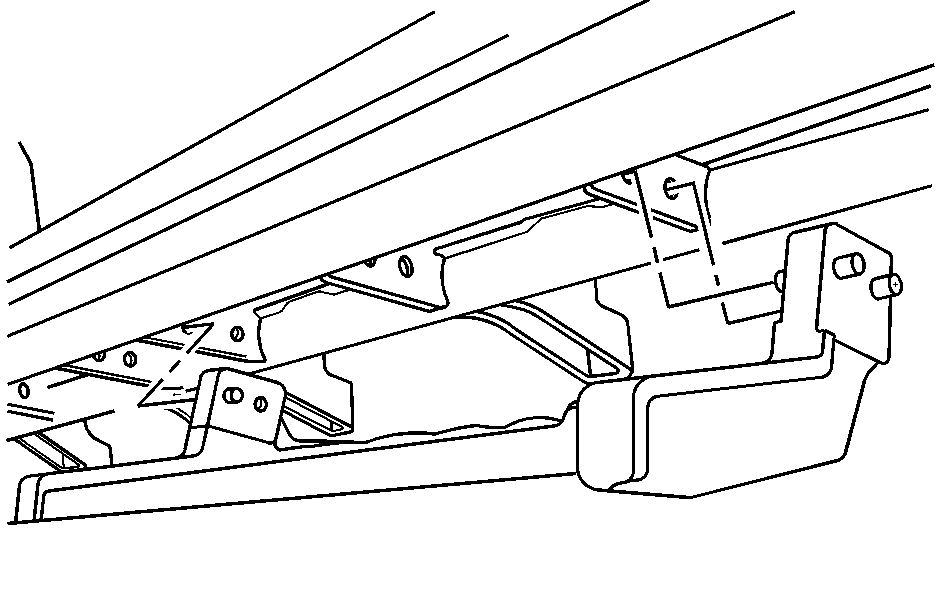
You will be guiding three pins into the holes with the fourth hole in the vehicle's rocker panel protector brackets empty until the next step.
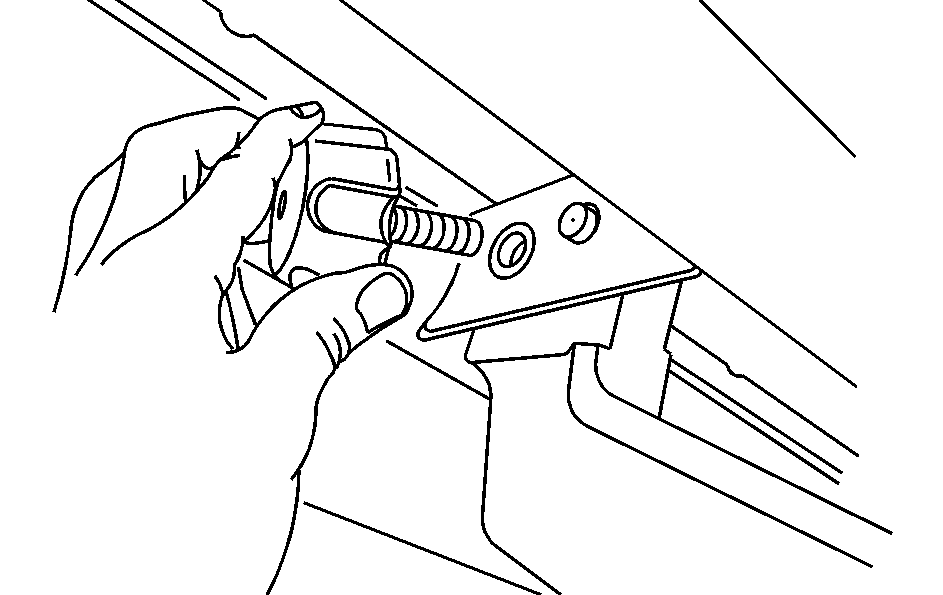
Notice: Threading the knob into the side step and then into the rocker panel will not secure the step. The step could fall off the vehicle and be damaged. Always thread the knob through the rocker panel first. After the knob is installed, try moving the step left and right to be sure the step is secure.
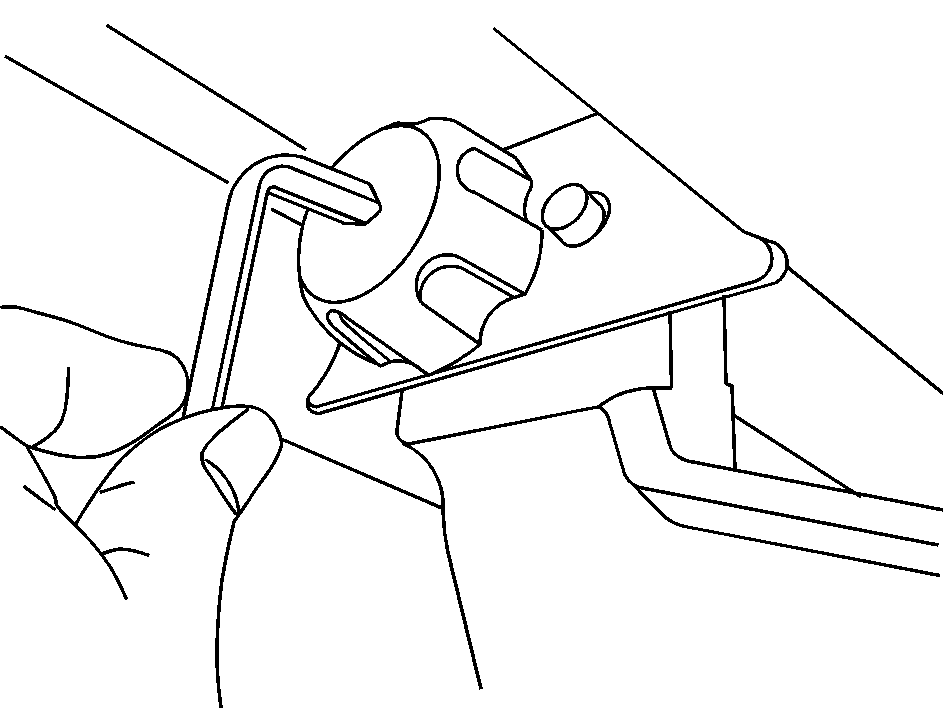

Once the knob is torqued, install the cotter pin through the hole in the end of the knob's threaded shaft.
This will help prevent the knob from coming completely loose and falling out.
Tubular Side Steps
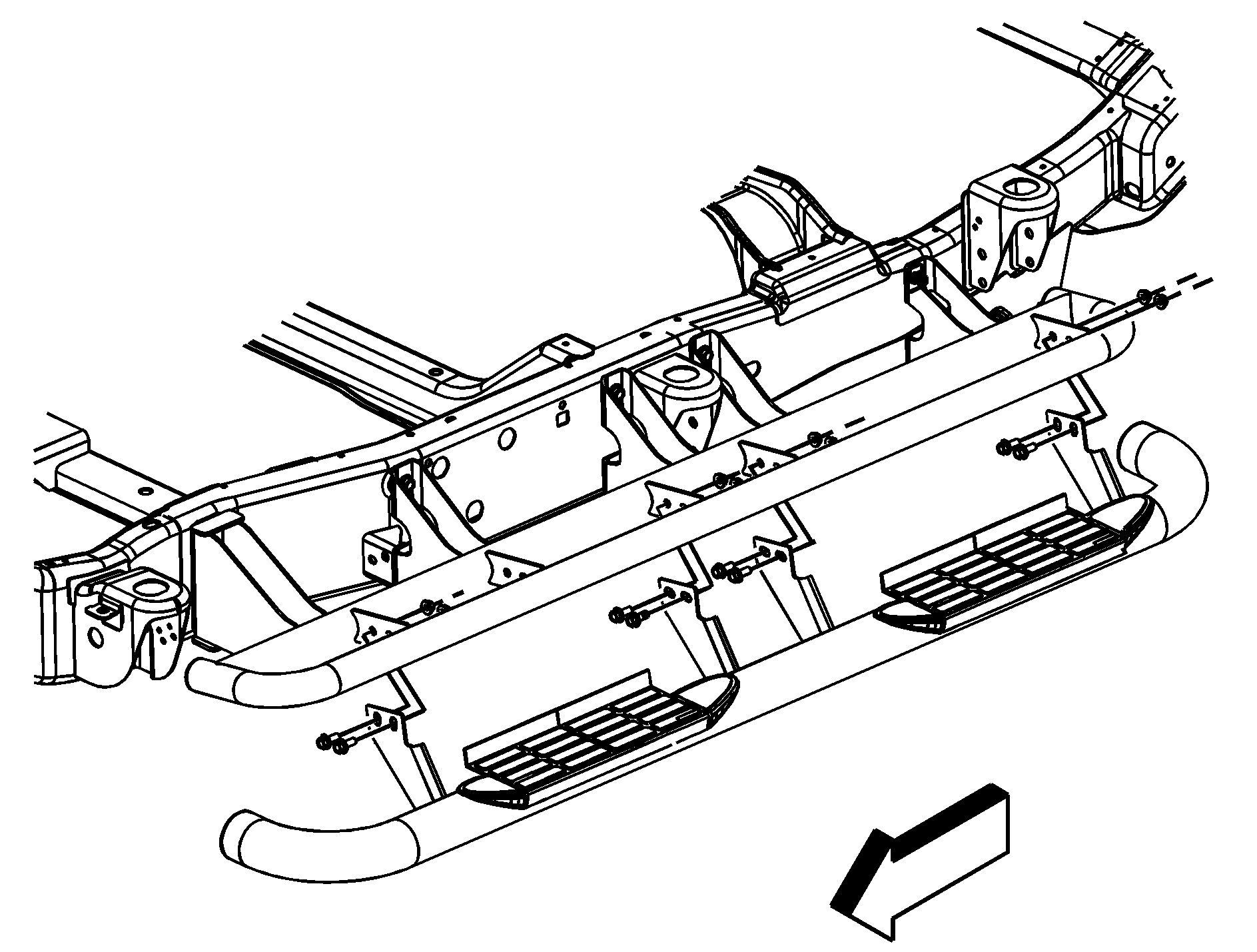
The driver's side of the vehicle is shown with the body removed for clarity. To remove a step:
- Remove the nuts and bolts attaching the step to the vehicle.
- Remove the step from the vehicle.
To install a step:
- Before installing the bolts:
- Install the side step to the vehicle. You may need someone to assist you in the installation.
- Install the nuts and bolts for the two inner brackets first, but do not tighten them.
- Using a level, make sure the step is level in relationship to the vehicle. Then, tighten the inner bracket nuts and bolts.
- Install the other nuts and bolts. Tighten all nuts and bolts to 39 lb ft (50 N·m).
| • | Remove all traces of the original adhesive patch. |
| • | Clean the threads of the bolts with denatured alcohol or equivalent and allow threads to dry. |
| • | Apply Threadlocker (GM Part No. 12345382, in Canada 10953489) or equivalent. |
Loading Your Vehicle for Off-Road Driving
There are some important things to remember about how to load your vehicle.
| • | The heaviest things should be on the load floor and forward of your rear axle. Put heavier items in the rear area, as far forward as you can. |
| • | Be sure the load is secured properly, so driving on the off-road terrain does not toss things around. |
Caution:
• Cargo on the load floor piled higher than the seatbacks can be thrown forward during a sudden stop. You or your passengers could be injured. Keep cargo below the top of the seatbacks. • Unsecured cargo on the load floor can be tossed about when driving over rough terrain. You or your passengers can be struck by flying objects. Secure the cargo properly. • Heavy loads on the roof raise the vehicle's center of gravity, making it more likely to roll over. You can be seriously or fatally injured if the vehicle rolls over. Put heavy loads inside the cargo area, not on the roof. Keep cargo in the cargo area as far forward and low as possible.
You will find other important information in this manual. See Loading the Vehicle and Tires .
Environmental Concerns
Off-road driving can provide wholesome and satisfying recreation. However, it also raises environmental concerns. We recognize these concerns and urge every off-roader to follow these basic rules for protecting the environment:
| • | Always use established trails, roads and areas that have been specially set aside for public off-road recreational driving; obey all posted regulations. |
| • | Avoid any driving practice that could damage the environment -- shrubs, flowers, trees, grasses -- or disturb wildlife (this includes wheel-spinning, breaking down trees or unnecessary driving through streams or over soft ground). |
| • | Always carry a litter bag -- make sure all refuse is removed from any campsite before leaving. |
| • | Take extreme care with open fires (where permitted), camp stoves and lanterns. |
| • | Never park your vehicle over dry grass or other combustible materials that could catch fire from the heat of the vehicle's exhaust system. |
Traveling to Remote Areas
It makes sense to plan your trip, especially when going to a remote area. Know the terrain and plan your route. You are much less likely to get bad surprises. Get accurate maps of trails and terrain. Try to learn of any blocked or closed roads.
It is also a good idea to travel with at least one other vehicle. If something happens to one of them, the other can help quickly.
Does your vehicle have a winch? If so, be sure to read the winch instructions. In a remote area, a winch can be handy if you get stuck. But you will want to know how to use it properly.
High Mobility Characteristics
The HUMMER H2 has a 10 inch (25.4 cm) running ground clearance (A) and a 9 inch (22.8 cm) axle to ground clearance (B) while maintaining a low silhouette and a low center of gravity.


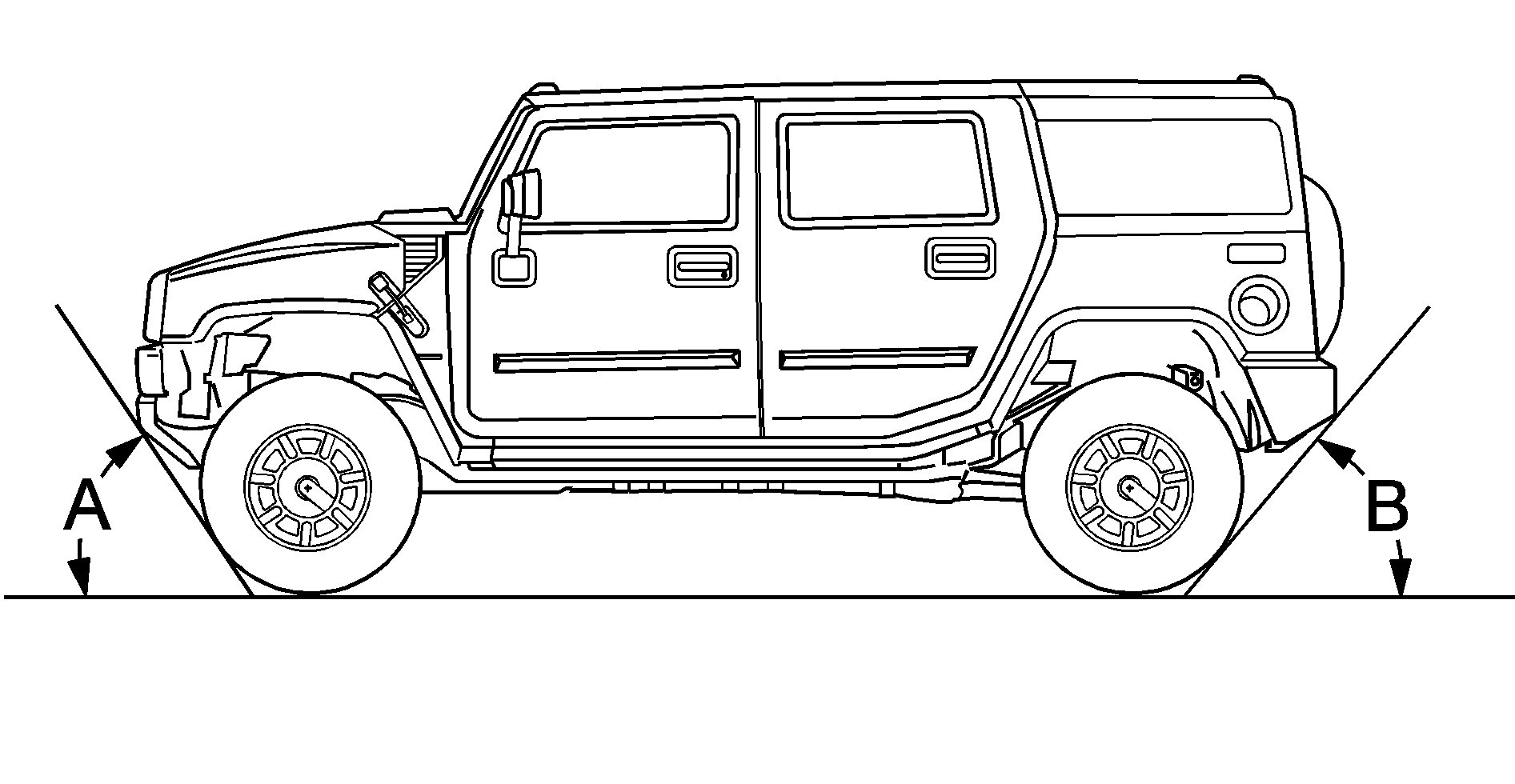
The HUMMER H2 has an approximate approach angle (A) of 42° and a departure angle (B) of 37°, depending on suspension packages.
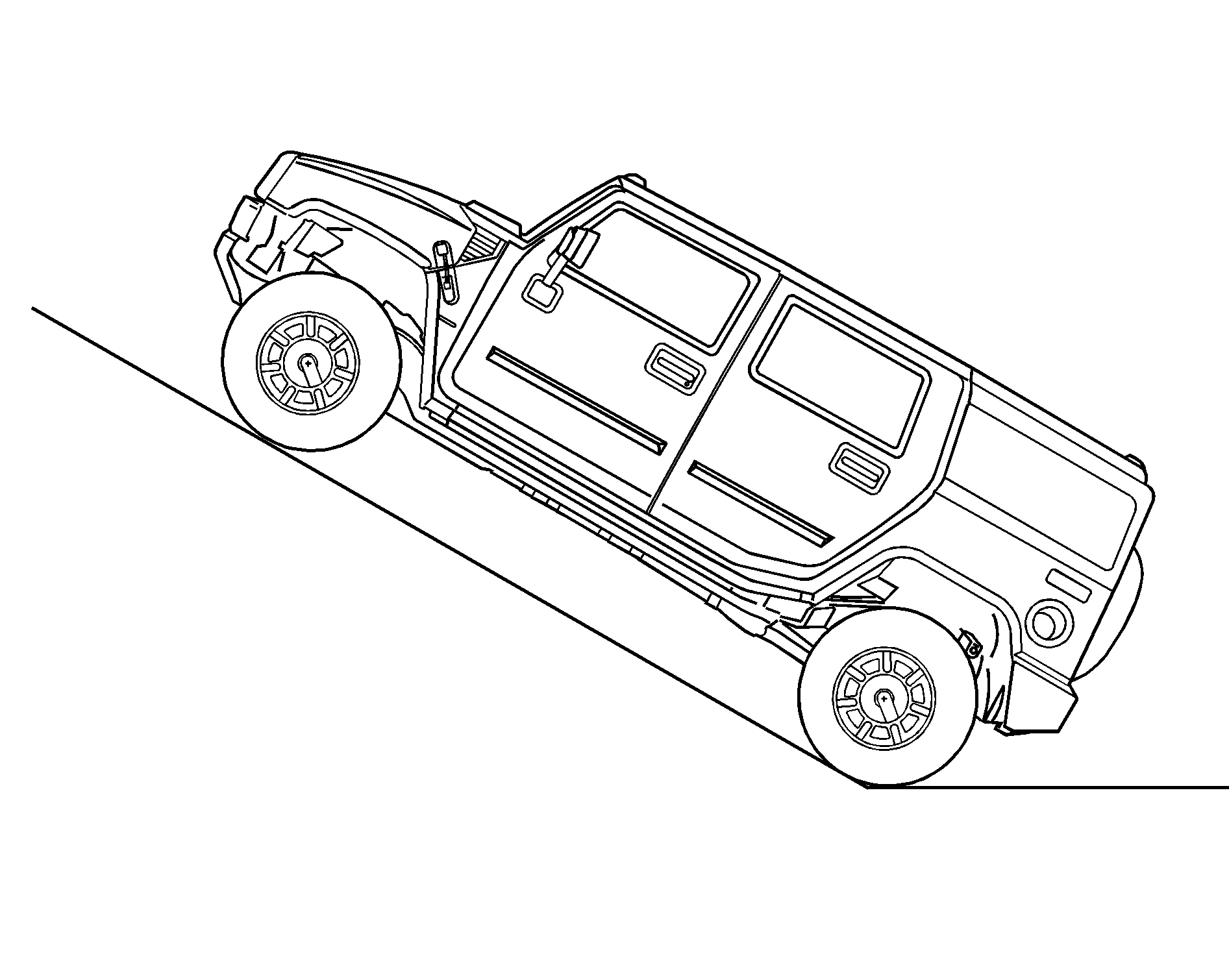
Design specifications required a minimum gradeability of 60% (31°) slope, with the vehicle fully loaded, on high friction surfaces at 6 mph (9.7 km/h). The vehicle is expected to traverse this grade only for short durations. Never stop and idle the vehicle or park it on this grade.
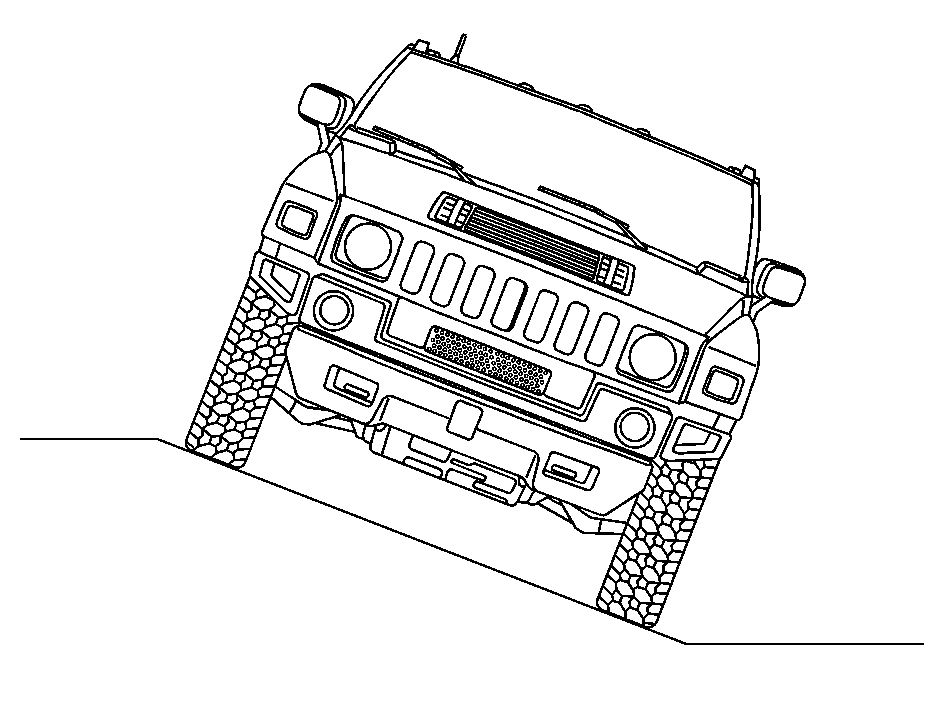
Also, your vehicle should be able to traverse a 40% (22°) side slope at 6 mph (9.7 km/h) while fully loaded on high friction surfaces.
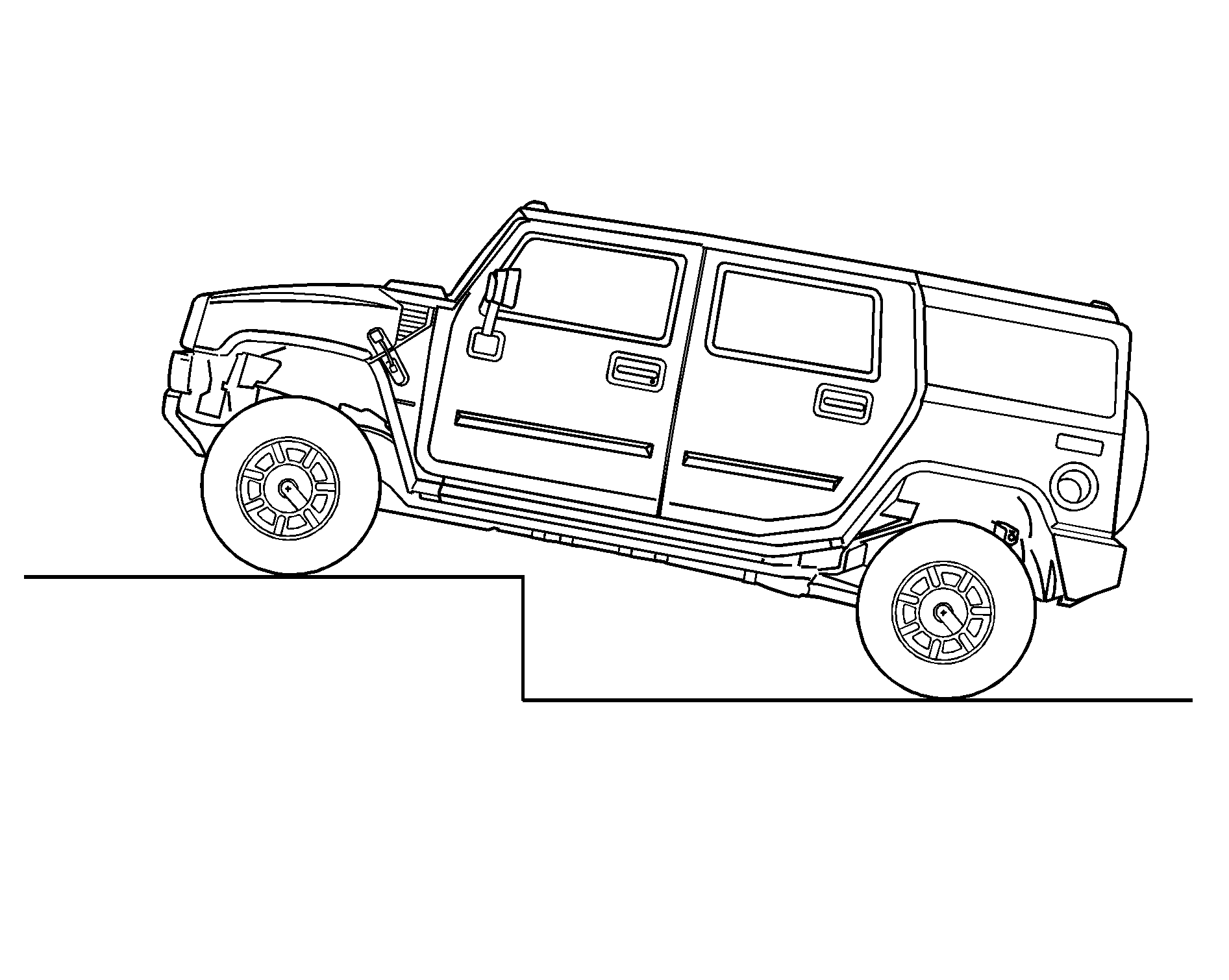
Your vehicle can climb a 16 inch (40.6 cm) vertical step. Step climbing is best done by approaching the step at an angle rather than straight on.
Brake and Accelerator Operation Techniques for Off-Road Driving
For logs, walls, rocks, severe ditches, hills, sand, etc.
- Bring the vehicle to a complete stop. Do not rev the engine.
- Select the proper transmission and transfer case gear range; usually FIRST (1) gear, 4LO LOCK for such obstacles.
- If wheel spin is experienced, maintain steady throttle, with your foot off the brake pedal, to allow the TCS to control the wheel spin. TCS will not operate if the brakes are applied, even slightly.
- If wheel spin cannot be controlled by the system, fully press the brake pedal with your left foot so all wheel spin is halted.
- Back away from the obstacle so that a new approach can be tried.
- As the first wheel crosses the obstacle, be prepared to alternate the brake and accelerator pedal to maintain control and avoid tire drop-off from obstacles. Repeat this process for the other wheels.
For mounds, washouts, loose up-hill slopes, ditches, etc.
When wheel spin occurs as the vehicle is moving, the driver may notice a slight shaking or shuddering of the vehicle. This should be stopped as soon as possible to prevent damage to vehicle components. This is the indication that a loss of traction is occuring on this terrain. The operator should:
- Reduce speed and apply the brakes.
- Assess the terrain properly and adjust vehicle speed and gear ranges accordingly: 4HI position for higher speeds and 4LO LOCK for more torque and lower speeds. Transmission FIRST (1) gear is generally recommended.
- Apply slight pressure to the brake when the shaking or shuddering sensation is felt, keeping the vehicle moving in a controlled manner.
- Be prepared to alternate between braking and accelerating through the adverse terrain.
Getting Familiar with Off-Road Driving
It is a good idea to practice in an area that is safe and close to home before you go into the wilderness. Off-road driving does require some new and different skills. Here is what we mean.
Tune your senses to different kinds of signals. Your eyes, for example, need to constantly sweep the terrain for unexpected obstacles. Your ears need to listen for unusual tire or engine sounds. With your arms, hands, feet and body, you will need to respond to vibrations and vehicle bounce.
Controlling your vehicle is the key to successful off-road driving. One of the best ways to control your vehicle is to control your speed. Here are some things to keep in mind. At higher speeds:
| • | you approach things faster and you have less time to scan the terrain for obstacles. |
| • | you have less time to react. |
| • | you have more vehicle bounce when you drive over obstacles. |
| • | you will need more distance for braking, especially since you are on an unpaved surface. |
Caution: When you are driving off-road, bouncing and quick changes in direction can easily throw you out of position. This could cause you to lose control and crash. So, whether you are driving on or off the road, you and your passengers should wear safety belts.
Scanning the Terrain
Off-road driving can take you over many different kinds of terrain. You need to be familiar with the terrain and its many different features. Here are some things to consider.
Surface Conditions: Off-roading can take you over hard-packed dirt, gravel, rocks, grass, sand, mud, snow or ice. Each of these surfaces affects the steering, acceleration and braking of your vehicle in different ways. Depending upon the kind of surface you are on, you may experience slipping, sliding, wheel spinning, delayed acceleration, poor traction and longer braking distances.Surface Obstacles: Unseen or hidden obstacles can be hazardous. A rock, log, hole, rut or bump can startle you if you are not prepared for them. Often these obstacles are hidden by grass, bushes, snow or even the rise and fall of the terrain itself. Here are some things to consider:
| • | Is the path ahead clear? |
| • | Will the surface texture change abruptly up ahead? |
| • | Does the travel take you uphill or downhill? (There is more discussion of these subjects later.) |
| • | Will you have to stop suddenly or change direction quickly? |
When you drive over obstacles or rough terrain, keep a firm grip on the steering wheel. Ruts, troughs or other surface features can jerk the wheel out of your hands if you are not prepared.
When possible, it is a good practice to survey the landscape ahead on foot prior to driving to observe hidden obstacles.
When you drive over bumps, rocks, or other obstacles, your wheels can leave the ground. If this happens, even with one or two wheels, you cannot control the vehicle as well or at all.
Because you will be on an unpaved surface, it is especially important to avoid sudden acceleration, sudden turns or sudden braking.
In a way, off-road driving requires a different kind of alertness from driving on paved roads and highways. There are no road signs, posted speed limits or signal lights. You have to use your own good judgment about what is safe and what is not.
Drinking and driving can be very dangerous on any road. And this is certainly true for off-road driving. At the very time you need special alertness and driving skills, your reflexes, perceptions and judgment can be affected by even a small amount of alcohol. You could have a serious -- or even fatal -- accident if you drink and drive or ride with a driver who has been drinking. See Drunk Driving .
Crossing Obstacles
Approach Angle -- a Key to Mobility
If you encounter a large dip in the terrain, do not enter straight on ; enter at an angle -- 15° minimum approach (A), 75° maximum approach angle (B). For very large dips, ditches or small washes, coast in, using the engine as a brake (transmission and transfer case lowest gears). Then, use the low ranges in the transmission and transfer case to power out.
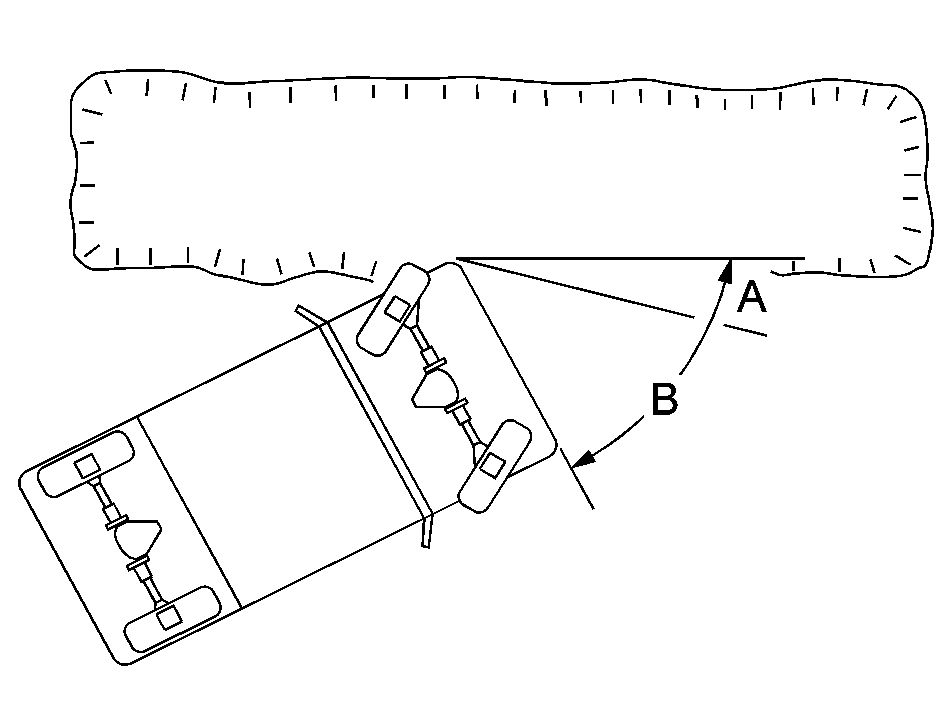
Roll Your Tires Over Large Rocks

Do not straddle large rocks; drive over them, letting the tire envelop the rock. The tread of the tire is thicker and tougher than the sidewall of the tire and is more resilient to impact than underbody components.
Log Crossing
Using the proper technique, your vehicle will cross logs up to 10 inches (25.4 cm) in diameter. Approach the log at approximately a 15° angle (A) with the transmission in FIRST (1) and the transfer case in 4LO LOCK and "walk" your vehicle over, one tire at a time. As with all obstacles, face your tires perpendicular to the object for best traction and tire life. It may be necessary to modulate your brake pedal and accelerator to avoid spin-out. Ease the vehicle down from the log with your brake.
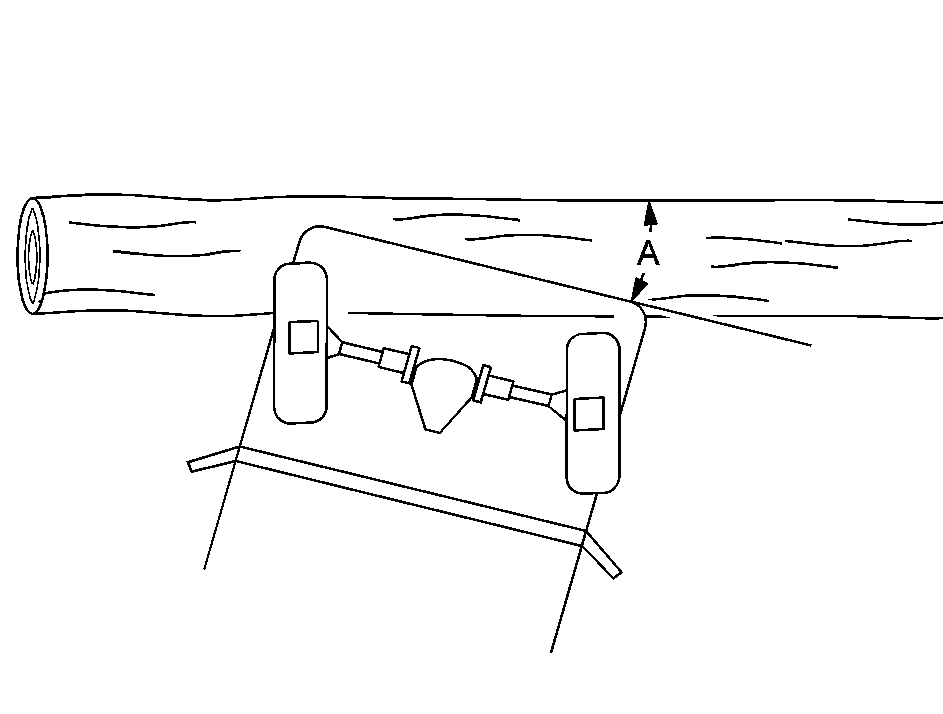
Driving on Off-Road Hills
Off-road driving often takes you up, down or across a hill. Driving safely on hills requires good judgment and an understanding of what your vehicle can and cannot do. There are some hills that simply cannot be driven, no matter how well built the vehicle.
Caution: Many hills are simply too steep for any vehicle. If you drive up them, you will stall. If you drive down them, you cannot control your speed. If you drive across them, you will roll over. You could be seriously injured or killed. If you have any doubt about the steepness, do not drive the hill.
Approaching a Hill
When you approach a hill, you need to decide if it is one of those hills that is just too steep to climb, descend or cross. Steepness can be hard to judge. On a very small hill, for example, there may be a smooth, constant incline with only a small change in elevation where you can easily see all the way to the top. On a large hill, the incline may get steeper as you near the top, but you may not see this because the crest of the hill is hidden by bushes, grass or shrubs.
Here are some other things to consider as you approach a hill:
| • | Is there a constant incline, or does the hill get sharply steeper in places? |
| • | Is there good traction on the hillside, or will the surface cause tire slipping? |
| • | Is there a straight path up or down the hill so you will not have to make turning maneuvers? |
| • | Are there obstructions on the hill that can block your path (boulders, trees, logs or ruts)? |
| • | What is beyond the hill? Is there a cliff, an embankment, a drop-off, a fence? Get out and walk the hill if you do not know. It is the smart way to find out. |
| • | Is the hill simply too rough? Steep hills often have ruts, gullies, troughs and exposed rocks because they are more susceptible to the effects of erosion. |
Driving Uphill
Once you decide you can safely drive up the hill, you need to take some special steps:
| • | Use transmission and transfer case low gear and get a firm grip on the steering wheel. |
| • | Get a smooth start up the hill and try to maintain your speed. Do not use more power than you need, because you do not want your wheels to start spinning or sliding. |
| • | Let the traction system work to control any wheel slippage. The traction control system allows for moderate wheel spin with some capability to dig in and power up the hill. |
| • | Do not continue if the vehicle shudders or exhibits suspension hopping. This can cause damage to the driveline or suspension components. Improper driving technique is not covered by your vehicle warranty. |
| • | Try to drive straight up the hill if at all possible. If the path twists and turns, you might want to find another route. |
| Caution: Turning or driving across steep hills can be dangerous. You could lose traction, slide sideways, and possibly roll over. You could be seriously injured or killed. When driving up hills, always try to go straight up. |
| • | Ease up on your speed as you approach the top of the hill. |
| • | Attach a flag to the vehicle to make you more visible to approaching traffic on trails or hills. |
| • | Sound the horn as you approach the top of the hill to let opposing traffic know you are there. |
| • | Use your headlamps even during the day. They make you more visible to oncoming traffic. |
Caution: Driving to the top (crest) of a hill at full speed can cause an accident. There could be a drop-off, embankment, cliff, or even another vehicle. You could be seriously injured or killed. As you near the top of a hill, slow down and stay alert.
Question:
What should I do if my vehicle stalls, or is about to stall, and I cannot make it up the hill?
Answer:
If this happens, there are some things you should do, and there are some things you must not do. First, here is what you should do:
| • | Push the brake pedal to stop the vehicle and keep it from rolling backwards. Also, apply the parking brake. |
| • | If your engine is still running, shift the transmission to REVERSE (R), release the parking brake, and slowly back down the hill in REVERSE (R). |
| • | If your engine has stopped running, you will need to restart it. With the brake pedal pressed and the parking brake still applied, shift the transmission to PARK (P) and restart the engine. Then, shift to REVERSE (R), release the parking brake, and slowly back down the hill as straight as possible in REVERSE (R). |
| • | As you are backing down the hill, put your left hand on the steering wheel at the 12 o'clock position. This way, you will be able to tell if your wheels are straight and maneuver as you back down. It is best that you back down the hill with your wheels straight rather than in the left or right direction. Turning the wheel too far to the left or right will increase the possibility of a rollover. |
Here are some things you must not do if you stall, or are about to stall, when going up a hill:
| • | Never attempt to prevent a stall by shifting into NEUTRAL (N) to rev-up the engine and regain forward momentum. This will not work. Your vehicle will roll backwards very quickly and you could go out of control. |
| Instead, apply the regular brake to stop the vehicle. Then apply the parking brake. Shift to REVERSE (R), release the parking brake, and slowly back straight down. |
| • | Never attempt to turn around if you are about to stall when going up a hill. If the hill is steep enough to stall your vehicle, it is steep enough to cause you to roll over if you turn around. If you cannot make it up the hill, you must back straight down the hill. |
Question:
Suppose, after stalling, I try to back down the hill and decide I just cannot do it. What should I do?
Answer:
Set the parking brake, put your transmission in PARK (P) and turn off the engine. Leave the vehicle and go get some help. Exit on the uphill side and stay clear of the path the vehicle would take if it rolled downhill. Do not shift the transfer case to NEUTRAL when you leave the vehicle. Leave it in some gear.
Caution: Shifting the transfer case to NEUTRAL can cause your vehicle to roll even if the transmission is in PARK (P). This is because the NEUTRAL position on the transfer case overrides the transmission. You or someone else could be injured. If you are going to leave your vehicle, set the parking brake and shift the transmission to PARK (P). But do not shift the transfer case to NEUTRAL. Leave the transfer case in the 4 HI, 4 HI Lock, or 4 LO Lock position.
Driving Downhill
When off-roading takes you downhill, you will want to consider a number of things:
| • | How steep is the downhill? Will I be able to maintain vehicle control? |
| • | What is the surface like? Smooth? Rough? Slippery? Hard-packed dirt? Gravel? |
| • | Are there hidden surface obstacles? Ruts? Logs? Boulders? |
| • | What is at the bottom of the hill? Is there a hidden creek bank or even a river bottom with large rocks? |
If you decide you can go down a hill safely, then try to keep your vehicle headed straight down, and use a low gear. This way, engine drag can help your brakes and they will not have to do all the work. Descend slowly, keeping your vehicle under control at all times.
Caution: Heavy braking when going down a hill can cause your brakes to overheat and fade. This could cause loss of control and a serious accident. Apply the brakes lightly when descending a hill and use a low gear to keep vehicle speed under control.
Question:
Are there some things I should not do when driving down a hill?
Answer:
Yes! These are important because if you ignore them you could lose control and have a serious accident:
| • | When driving downhill, avoid turns that take you across the incline of the hill. A hill that is not too steep to drive down may be too steep to drive across. You could roll over if you do not drive straight down. |
| • | Never go downhill with the transmission in NEUTRAL (N). This is called "free-wheeling." Your brakes will have to do all the work and could overheat and fade. |
Question:
Am I likely to stall when going downhill?
Answer:
It is much more likely to happen going uphill. But if it happens going downhill, here is what to do:
- Stop your vehicle by applying the regular brakes. Apply the parking brake.
- Shift to PARK (P) and, while still braking, restart the engine.
- Shift back to a low gear, release the parking brake, and drive straight down.
- If the engine will not start, get out and get help.
Driving Across an Incline
Sooner or later, an off-road trail will probably go across the incline of a hill. If this happens, you have to decide whether to try to drive across the incline. Here are some things to consider:
| • | A hill that can be driven straight up or down may be too steep to drive across. When you go straight up or down a hill, the length of the wheel base (the distance from the front wheels to the rear wheels) reduces the likelihood the vehicle will tumble end over end. But when you drive across an incline, the much more narrow track width (the distance between the left and right wheels) may not prevent the vehicle from tilting and rolling over. Also, driving across an incline puts more weight on the downhill wheels. This could cause a downhill slide or a rollover. |
| • | Surface conditions can be a problem when you drive across a hill. Loose gravel, muddy spots, or even wet grass can cause your tires to slip sideways, downhill. If the vehicle slips sideways, it can hit something that will trip it (a rock, a rut, etc.) and roll over. |
| • | Hidden obstacles can make the steepness of the incline even worse. If you drive across a rock with the uphill wheels, or if the downhill wheels drop into a rut or depression, your vehicle can tilt even more. |
For reasons like these, you need to decide carefully whether to try to drive across an incline. Just because the trail goes across the incline does not mean you have to drive it. The last vehicle to try it might have rolled over.
Caution: Driving across an incline that is too steep will make your vehicle roll over. You could be seriously injured or killed. If you have any doubt about the steepness of the incline, do not drive across it. Find another route instead.
Question:
What if I am driving across an incline that is not too steep, but I hit some loose gravel and start to slide downhill. What should I do?
Answer:
If you feel your vehicle starting to slide sideways, turn downhill. This should help straighten out the vehicle and prevent the side slipping. However, a much better way to prevent this is to get out and "walk the course" so you know what the surface is like before you drive it.
Stalling on an Incline
If your vehicle stalls when you are crossing an incline, be sure you (and your passengers) get out on the uphill side, even if the door there is harder to open. If you get out on the downhill side and the vehicle starts to roll over, you will be right in its path.
If you have to walk down the slope, stay out of the path the vehicle will take if it does roll over.
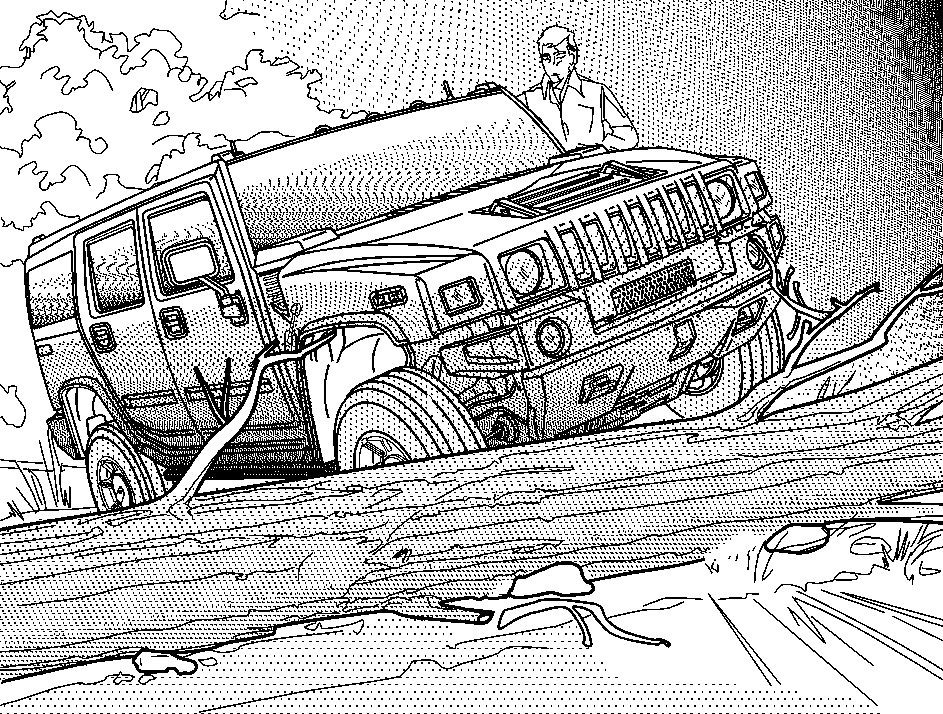
Caution: Getting out on the downhill (low) side of a vehicle stopped across an incline is dangerous. If the vehicle rolls over, you could be crushed or killed. Always get out on the uphill (high) side of the vehicle and stay well clear of the rollover path.
Driving in Mud, Sand, Snow or Ice
When you drive in mud, snow or sand, your wheels will not get good traction. You cannot accelerate as quickly, turning is more difficult, and you will need longer braking distances.
It is best to use a low gear when you are in mud -- the deeper the mud, the lower the gear. In really deep mud, the idea is to keep your vehicle moving so you do not get stuck. Be careful to keep mud from building up and washing onto the engine cooling system.
When you drive on sand, you will sense a change in wheel traction. But it will depend upon how loosely packed the sand is. On loosely packed sand (as on beaches or sand dunes) your tires will tend to sink into the sand. This has an effect on steering, accelerating and braking. Drive at a reduced speed and avoid sharp turns or abrupt maneuvers.
Hard packed snow and ice offer the worst tire traction. On these surfaces, it is very easy to lose control. On wet ice, for example, the traction is so poor that you will have difficulty accelerating. And if you do get moving, poor steering and difficult braking can cause you to slide out of control.
Caution: Driving on frozen lakes, ponds, or rivers can be dangerous. Underwater springs, currents under the ice, or sudden thaws can weaken the ice. Your vehicle could fall through the ice and you and your passengers could drown. Drive your vehicle on safe surfaces only.
Driving in Water
Heavy rain can mean flash flooding, and flood waters demand extreme caution.
Find out how deep the water is before you drive through it. If it is deep enough to cover your wheel hubs, axles or exhaust pipe, do not try it -- you probably will not get through. Also, water that deep can damage your axle and other vehicle parts. Your vehicle is capable of depths up to 20 inches. Know how to judge whether the water is deeper than this before proceeding into it.
If the water is not too deep, drive slowly through it. At faster speeds, water splashes on your ignition system and your vehicle can stall. Stalling can also occur if you get your tailpipe under water. And, as long as your tailpipe is under water, you will never be able to start your engine. When you go through water, remember that when your brakes get wet, it may take you longer to stop.
Caution: Driving through rushing water can be dangerous. Deep water can sweep your vehicle downstream and you and your passengers could drown. If it is only shallow water, it can still wash away the ground from under your tires, and you could lose traction and roll the vehicle over. Do not drive through rushing water.
See Driving in Rain and on Wet Roads for more information on driving through water.
After Off-Road Driving
Remove any brush or debris that has collected on the underbody, chassis or under the hood. These accumulations can be a fire hazard.
After operation in mud or sand, have the brake linings cleaned and checked. These substances can cause glazing and uneven braking. Check the engine and oil coolers for mud accumulation. Thoroughly and carefully clean these devices to allow proper cooling. Check the body structure, steering, suspension, wheels, tires and exhaust system for damage. Also, check the fuel lines and cooling system for any leakage.
Your vehicle will require more frequent service due to off-road use. Refer to the Maintenance Schedule for additional information.
